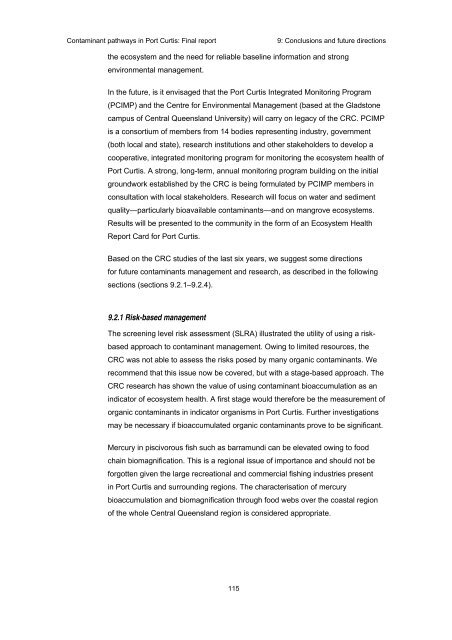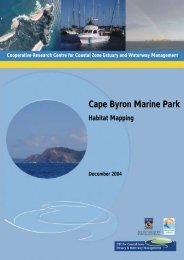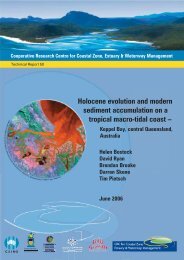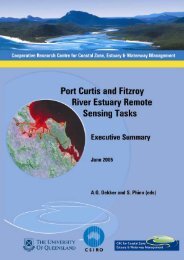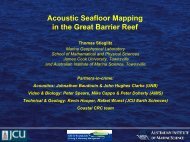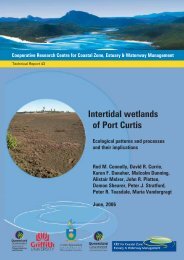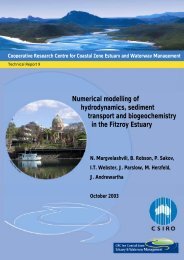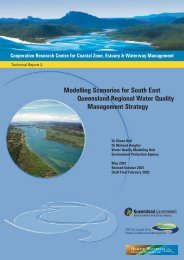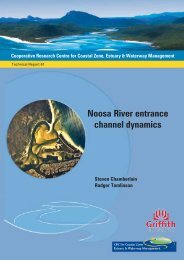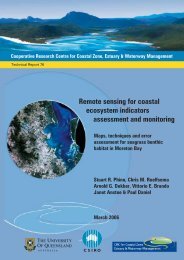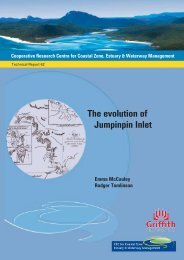Contaminant pathways in Port Curtis: Final report - OzCoasts
Contaminant pathways in Port Curtis: Final report - OzCoasts
Contaminant pathways in Port Curtis: Final report - OzCoasts
Create successful ePaper yourself
Turn your PDF publications into a flip-book with our unique Google optimized e-Paper software.
<strong>Contam<strong>in</strong>ant</strong> <strong>pathways</strong> <strong>in</strong> <strong>Port</strong> <strong>Curtis</strong>: F<strong>in</strong>al <strong>report</strong>9: Conclusions and future directionsthe ecosystem and the need for reliable basel<strong>in</strong>e <strong>in</strong>formation and strongenvironmental management.In the future, is it envisaged that the <strong>Port</strong> <strong>Curtis</strong> Integrated Monitor<strong>in</strong>g Program(PCIMP) and the Centre for Environmental Management (based at the Gladstonecampus of Central Queensland University) will carry on legacy of the CRC. PCIMPis a consortium of members from 14 bodies represent<strong>in</strong>g <strong>in</strong>dustry, government(both local and state), research <strong>in</strong>stitutions and other stakeholders to develop acooperative, <strong>in</strong>tegrated monitor<strong>in</strong>g program for monitor<strong>in</strong>g the ecosystem health of<strong>Port</strong> <strong>Curtis</strong>. A strong, long-term, annual monitor<strong>in</strong>g program build<strong>in</strong>g on the <strong>in</strong>itialgroundwork established by the CRC is be<strong>in</strong>g formulated by PCIMP members <strong>in</strong>consultation with local stakeholders. Research will focus on water and sedimentquality—particularly bioavailable contam<strong>in</strong>ants—and on mangrove ecosystems.Results will be presented to the community <strong>in</strong> the form of an Ecosystem HealthReport Card for <strong>Port</strong> <strong>Curtis</strong>.Based on the CRC studies of the last six years, we suggest some directionsfor future contam<strong>in</strong>ants management and research, as described <strong>in</strong> the follow<strong>in</strong>gsections (sections 9.2.1–9.2.4).9.2.1 Risk-based managementThe screen<strong>in</strong>g level risk assessment (SLRA) illustrated the utility of us<strong>in</strong>g a riskbasedapproach to contam<strong>in</strong>ant management. Ow<strong>in</strong>g to limited resources, theCRC was not able to assess the risks posed by many organic contam<strong>in</strong>ants. Werecommend that this issue now be covered, but with a stage-based approach. TheCRC research has shown the value of us<strong>in</strong>g contam<strong>in</strong>ant bioaccumulation as an<strong>in</strong>dicator of ecosystem health. A first stage would therefore be the measurement oforganic contam<strong>in</strong>ants <strong>in</strong> <strong>in</strong>dicator organisms <strong>in</strong> <strong>Port</strong> <strong>Curtis</strong>. Further <strong>in</strong>vestigationsmay be necessary if bioaccumulated organic contam<strong>in</strong>ants prove to be significant.Mercury <strong>in</strong> piscivorous fish such as barramundi can be elevated ow<strong>in</strong>g to foodcha<strong>in</strong> biomagnification. This is a regional issue of importance and should not beforgotten given the large recreational and commercial fish<strong>in</strong>g <strong>in</strong>dustries present<strong>in</strong> <strong>Port</strong> <strong>Curtis</strong> and surround<strong>in</strong>g regions. The characterisation of mercurybioaccumulation and biomagnification through food webs over the coastal regionof the whole Central Queensland region is considered appropriate.115


